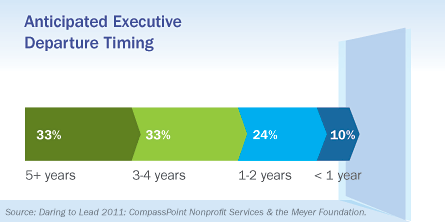Career Path & Transition
Jun 13, 2011 by Marla Cornelius in Career Path & Transition
These are the key findings from Daring to Lead 2011 related to executive director career paths, succession, and transition. For more information download the full report in PDF.
Path to Current Position — Nearly half of executives—48%—were internal hires: 31% were previously on staff and 17% were on the board. Thirty-two percent (32%) were external hires and 20% were founders.
Current Tenure — Nearly a third of current executives (31%) have been on the job for fewer than three years. Twenty-seven (27%) have been on the job for 10 or more years.
Anticipated Executive Departure Timing — Seven percent (7%) of executives have given notice and 67% anticipate leaving within five years. Within that 67%, 10 percent (10%) who have not given notice say they are actively considering leaving.
Succession Planning — Seventeen percent (17%) of organizations have a documented succession plan. Just 33% of executives are very confident that their boards will hire the right successor when they leave.
Performance Evaluation — Forty-five percent (45%) of executives did not have a performance evaluation last year. Among the majority of executives who did have a review within the past year, just a third (32%) said it was either somewhat useful or very useful, with the remaining two thirds reporting that it was only a little useful (53%) or not useful at all (15%).
Predecessor Departure — Thirty-three percent (33%) of current executives followed a leader who was fired or forced to resign.
Shared Leadership & Bench Strength — A large majority of executives lead their organizations with a style that could be characterized as shared leadership (an approach that is inclusive, collaborative, and shares leadership responsibilities with others throughout the organization). Fifty-seven percent (57%) said shared leadership very much describes their style, while 34% reported that it somewhat describes their style. Eighty-one percent (81%) of executives thought that the majority of their staff would describe them as practicing shared leadership as well.
Executives expressed confidence in the decision-making capabilities of their staffs, with 81% reporting at least one person on staff that they trusted to make important organizational decisions without consultation from them first.
Thirty-six percent (36%) of leaders said there would not be a credible staff candidate for the executive position should they leave today. Among executives with staffs larger than 100 people, 27% reported no credible candidate for their job on staff.



Jean Lobell
30. Jun, 2011
Your study gives meaning to one elusive process for most nonprofit organizations – the challenge of succession or leadership transition planning. Boards and EDs are of course concerned about WHO would lead the organization once the current executive leaves. However, our sector has not paid as much attention to HOW and WHEN this process should take place. The data in this study attests to this with only 17% of organizations reporting having a documented succession plan.
With only a third of executives feeling very confident that their boards will hire the right successor when they leave, what can be done to support Boards in exercising more thoughtful and systematic planning around leadership transitions? Board members are not necessarily schooled in this process unless they have been part of such a process in another setting. The challenge is exacerbated by the fact that this is additional work for Board members whose plates are already quite full.
CRE has a healthy search practice and one of the challenges we have had to manage are Boards who are well intentioned but under-prepared to make leadership transition decisions. With about a third of leaders indicating that there would not be a credible staff candidate for the executive position should they leave today, Boards are therefore faced with external candidates whom they have to really get to know within several interactions and from resumes that are understandably written in the most positive light. To do this effectively, Boards have to be crystal clear about the criteria and success indicators for the kind of leadership the organization needs for the next 3-5 years. This plus a sharper screening and vetting process of external candidates is paramount to avoiding “mishires.” Such a process is part of a high quality leadership transition plan.
Related to the dearth of succession planning is the low occurrence of effective ED performance evaluations. Effective and useful performance reviews are helpful not only for the ED but also the Board. It becomes incumbent upon the latter to get to know the responsibilities, accomplishments, and challenges of the ED, as well as the impact of the ED’s performance on the organization. It is an excellent prelude to thinking about the kind of leadership the organization needs for the future, which of course is the foundation of a good succession plan.
So why don’t our nonprofits give more attention to this? What can we do to support Boards and executives take on this process? We have some thoughts which we will post in our CRE blog soon.
Jean Lobell
Senior Managing Director
Community Resource Exchange
Molly Cannon Stevenson, CFRE
15. Jul, 2011
I agree with Jean. And, what could we do to support local funders to support well-managed transitions, professional development and succession in their grantee organizations?